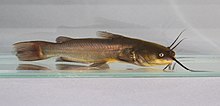
Back الثيران السوداء ARZ Ameiurus melas Bulgarian Peix gat negre Catalan Ameiurus melas CEB Sumeček černý Czech Schwarzer Zwergwels German Pés gat EML Ameiurus melas Spanish Ameiurus melas Basque Mustapiikkimonni Finnish
| Black bullhead | |
|---|---|

| |
| Scientific classification | |
| Domain: | Eukaryota |
| Kingdom: | Animalia |
| Phylum: | Chordata |
| Class: | Actinopterygii |
| Order: | Siluriformes |
| Family: | Ictaluridae |
| Genus: | Ameiurus |
| Species: | A. melas
|
| Binomial name | |
| Ameiurus melas Rafinesque, 1820
| |

| |
| Global range of A. melas | |
| Synonyms | |
| |
The black bullhead or black bullhead catfish (Ameiurus melas) is a species of bullhead catfish. Like other bullhead catfish, it has the ability to thrive in waters that are low in oxygen, brackish, turbid, and/or very warm.[2] It also has barbels located near its mouth, a broad head, spiny fins, and no scales. It can be identified from other bullheads as the barbels are black, and it has a tan crescent around the tail. Its caudal fin is truncated (squared off at the corners).[3] Like virtually all catfish, it is nocturnal, preferring to feed at night, although young feed during the day. It generally does not get as large as the channel or blue catfish, with average adult weights are in the 1-to-2-pound (0.45 to 0.91 kg) range, and almost never as large as 4 pounds (1.8 kg). It has a typical length of 6–14 inches (15–36 cm), with the largest specimen being 24 inches (61 cm), making it the largest of the bullheads.[citation needed] It is typically black or dark brown on the dorsal side of its body and yellow or white on the ventral side.[3]
Like most of the bullheads (and even flathead catfish), it has a squared tail fin, which is strikingly different from the forked tail of channel and blue catfish. It is a bottom-rover fish, meaning it is well-adapted for bottom living. It is typically dorsoventrally flattened, and has a slightly humped back.[4] Its color depends on the area where it is taken, but it generally is darker than brown or yellow bullheads (A. nebulosus and A. natalis, respectively). It can be distinguished from a flathead catfish (Pylodictis olivaris) by the fact that the black bullhead's lower lip does not protrude past the upper lip. Distinguishing it from the brown bullhead is a bit more difficult, depending on the area where it is caught, but a distinguishing detail between the two includes a nearly smooth pectoral spine on the black bullhead, while the brown's corresponding spine is strongly barbed. The anal fin of the black bullhead also has a gray base, and its tail has a pale bar. Also, the brown bullhead generally has 21 to 24 soft rays through its anal fin as opposed to the black bullhead's 17 to 21. The brown bullhead is also typically mottled brown and green on top instead of the darker black. Both the black and brown bullheads can easily be distinguished from the yellow bullhead by the color of the barbels on their chin: the yellow bullhead has white barbels under its mouth.[5]
- ^ NatureServe (2013). "Ameiurus melas". IUCN Red List of Threatened Species. 2013: e.T202674A2746540. doi:10.2305/IUCN.UK.2013-1.RLTS.T202674A2746540.en. Retrieved 13 November 2021.
- ^ Black Bullhead Detailed Information – Montana Animal Field Guide Archived July 1, 2007, at the Wayback Machine
- ^ a b "Catfish".
- ^ "Fish Adaptations | MDC". Archived from the original on 2011-03-17. Retrieved 2011-05-19.
- ^ Phillips, G.L, Schmid, W.D, & Underhill, J.C. (1991). Fishes of the Minnesota region. Minneapolis: University of Minnesota Press.
© MMXXIII Rich X Search. We shall prevail. All rights reserved. Rich X Search
